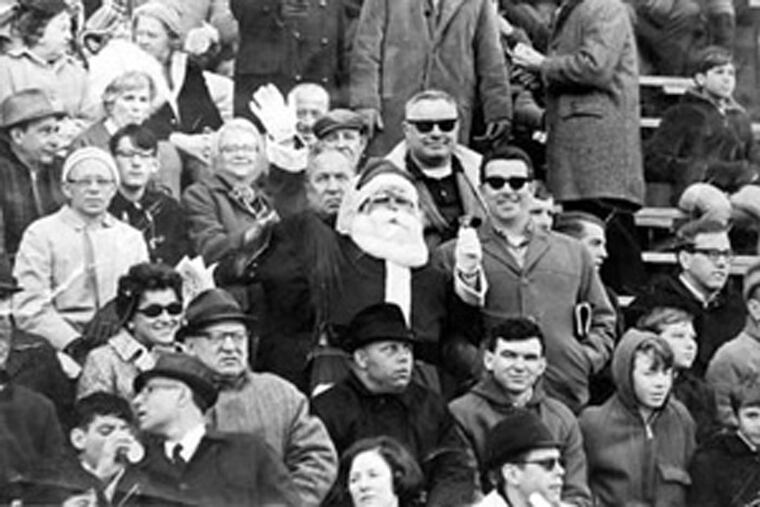Bad Philly fan behavior explained - to a point
Blame "the bracelet incident" on the brain, Philadelphia fans, because human beings can be helpless during a terrible hockey game, unable to resist the sense of release that comes with joining a crowd booing or throwing something on the ice.

Blame "the bracelet incident" on the brain, Philadelphia fans, because human beings can be helpless during a terrible hockey game, unable to resist the sense of release that comes with joining a crowd booing or throwing something on the ice.
The key to Monday night's rain of light-up bracelets at the Wells Fargo Center, experts say, would be finding Patient Zero, the first disgruntled Flyers fan who sparked the latest municipal embarrassment by tossing his or her NHL playoffs bracelet toward the ice.
"Nobody on their own, individually, would behave that way," said Susan Krauss Whitbourne, a professor of psychological and brain sciences at the University of Massachusetts Amherst. "It goes beyond sports fandom in my opinion. It's crowd behavior. It's people seeing people do things, behaving a certain way, and following.
"I don't imagine it's a dry arena, either."
Flyers management released a statement Tuesday calling the team's fans the "best in sports," but still expressed regret over what happened during Monday night's 6-1 drubbing by the Washington Capitals, when about 100 fans littered the ice.
"Flyers fans have the right to voice their displeasure vocally or by not watching or attending games, but when displeasure is expressed in a way that embarrasses or endangers others," the statement read, "it cannot be condoned or tolerated."
Are Philadelphia fans just "passionate," as goalie Steve Mason put it Tuesday?
Or are they "cruel and crabbed," as sportswriter Jimmy Cannon wrote in the early 1970s?
Monday's loss followed an emotional pregame tribute to Ed Snider, the Flyers' chairman, who died April 11 at age 83.
In the midst of the bracelet-tossing, Flyers announcer Lou Nolan chided fans: "This is Philly. Act with class."
All this makes a red-blooded Philly fan want to point out classless things other teams' fans have done, like the guy in Ontario who was fined $200 for throwing a banana at Flyers winger Wayne Simmonds in 2011.
Simmonds was frustrated and vocal about the bracelets during Monday's game. The fans' behavior prompted a delay-of-game penalty that the team had to kill off, five on three.
"We have more guys out there putting their bodies on the line, trying to block shots," Simmonds said. "And it could have ultimately ended in an injury. Luckily, it didn't. It's not like we're not going out there giving an effort. Because we are going out there busting our butts."
Frank Farley, a Temple University psychology professor and a native of the Canadian province of Alberta, said the team's ugly play triggered mass agitation. "Frustration produces aggression," he said.
While the bracelets were a new wrinkle, messages from the stands are nothing new in hockey or other spectator sports.
In Detroit, the flying octopus became a thing. Fans around the league have hurled rubber rats, real sharks, hamburgers, and waffles. Monday night at the Wells Fargo Center, a hot dog hit the ice.
The bracelets touched off a new round of complaint about the Philadelphia fans. But bad behavior is by no means confined to the local sports enthusiasts.
"I've seen this in Europe," said Flyers center Pierre-Edouard Bellemare, a Frenchman, "but I was not expecting this. I understand the frustration of the fans. It's not something you want to see your fans do."
It was Bellemare's five-minute checking-from-behind penalty and game misconduct that triggered the flurry of wristbands.
Whitbourne said one act of bad behavior can trigger emotional contagion anywhere. "Other people's moods affect your own," she said.
Still, the incident resurrected the old memes about Philly anger.
Commentator Keith Olbermann compared the team to the Broad Street Bullies on Twitter, "except, you know, with no appreciable hockey skills."
Former World Wrestling Entertainment star and aspiring UFC fighter CM PUNK simply tweeted, "I knew those bracelets were a bad idea . . . "
A Capitals blog dug deeper into the game with this headline: "A Summary of All the Disgraceful Things Flyers Fans Did During Game Three." For instance, did you know a Flyers fan was caught on camera taking a middle finger selfie at the Caps' bench?
Philadelphia Police Detective Joseph Murray put the mess into perspective with this tweet: "A dude killed 3 people with a shotgun, cop got shot and a guy killed his daughter this weekend. But Flyers fans threw bracelets . . .."
Historically, the pelting of a Santa Claus during an Eagles game in 1968 has been the Philly fans' ugliest scar. Lots of people didn't throw snowballs that day, though, and thousands of people now have Flyers bracelets on their bureaus, able to resist the lure of collective disgust.
Still, these things did happen.
The toughest words might seemingly have come from beyond the grave, but were a message for Philly fans and out-of-towners too, whether it's about the bracelets, Santa, batteries, or anything they might regret.
"My dad would've called the wristband throwers a 'disgrace' & may have spoken publicly," Snider's daughter, Sarena, tweeted Tuesday morning. "But he wouldn't look back, only forward."
215-854-5916@jasonnark